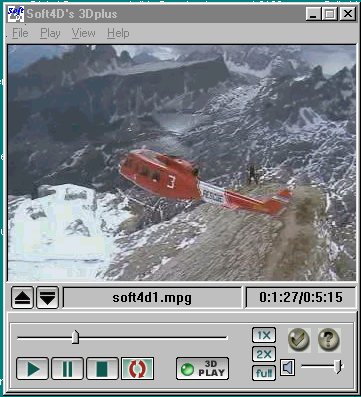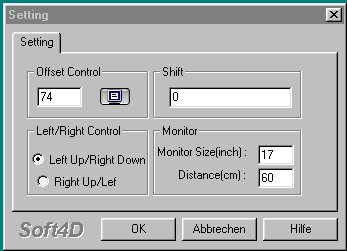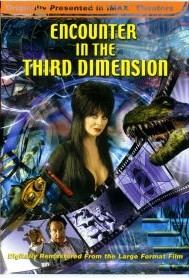3Dplus software by Soft4D
realtime 2D-to-3D VCD (mpeg1) & DVD (mpeg2) video conversion for shutterglasses
review by Christoph Bungert
page initialy released on
May 13, 2001
last update on June 28,
2003
related links:
www.soft4d.com
3dplus-hardware
review
Content
introduction
version
1.0 for VCD/MPEG1
New: version
2.0 for DVD/MPEG2
Several companies around the world are working on ways to convert movies which were originally shot with a single 2D-camera into a stereoscopic 3D format. This conversion can be done in realtime - like 3Dplus does - or via preprocessing. In the latter case the resulting stereo3D-stream has to be stored somewhere, for example on a 3D-VHS tape for shutterglasses.
shooting in stereo
If one shoots a photo or motion picture with a stereo3d-camera, i.e. with two lenses, the results are stereo-pairs with very delicate differences between the two perspectives. These differences are processed by the human brain in a way noone understands in detail yet. Even small slipups in the stereo-photography can make the resulting 3D-image unbelievable or at least uncomfortable to the viewer.
2D to 3D conversion
Now, how is 2D-to-3D conversion supposed to work? Basically the guys
who attempt this are looking for information which is - for the most part
- not there! Stereoscopic3D is about information and by using a standard
single-lensed camera the moviemaker decides to throw this informtion away
for all eternity. It's like shooting in black & white. You'll loose
the true colors forever. I just said the information isn't there for the
'most' part. So what about the 'other' part?
The answer: there is some stereo-information hidden in every movie.
The secret is 'motion'. A 3d-camera shoots the same scene at the exact
same instant in time from two different positions. The two camera lenses
are aligned horizontally, just like the human eyes. A standard camera can't
shoot two perspectives at the same time, but it can do so over time. If
the camera (or some object) moves horizontally at a certain speed and if
you take two successive shots you get something which is pretty similar
to a stereo-pair.
Pulfrich3D on TV ![]()
On TV this fact is used for a 3D-system which is usually called Pulfrich-3D after Carl Pulfrich (1858-1927), a german physicist, inventor of the stereoscopic range finder and other important measuring instruments. This 3D-TV system uses cardboard glasses which have a dark and a light filter. The human visual system gets slower the darker an image is. So the dark filter slows one of the eyes down. As a result the very same image is seen by the right eye later than by the left eye. In effect two successive images which were aired by the TV-station one after the other reach the brain at the same time. So two successive images are experienced by the brain as one image. If these two images deliver two different perspectives in the right manner, they are perceived as a stereoscopic3D-image. In order to get the brain into believing to see stereo images the camera - which is a standard 2D camera - has to constantly move horizontally in a certain direction at a certain speed. If the camera stops the 3D-effect goes away. Now let's say the camera is still and an actor moves his arm horizontally there will be some short, strange, partial 3D-effect on his arm, but you don't get anything comparable to the real 3d-shots.
ver. 1.0.0131 and 1.0.0401 tested
The Soft4D realtime 2D-to-3D video converter is bundled with the Soft4D 3dplus hardware package. The hardware is identical to the i-Art Eye3D-Force. Other bundles are planned as well as implementation of the software-technology into DVD-players and TV-sets. The current software works for MPEG1-streams, i.e. Video-CD's and clips from the web. Soft4D is an asian company and in Asia the VideoCD-format was a huge success, in Europe and the USA it was not, so the software-base isn't so good to begin with. Support for MPEG2 (DVD) is planned, but will require enormous processing power.

the 3Dplus time-shift
The 3Dplus conversion software tries to use information hidden in movements. Using shutterglasses technology it sends the original stream of images to one eye and a time-shifted stream of images to the other eye. So one eye sees each image a little later or a little earlier than the other eye. Opposed to simple cardboard Pulfrich glasses the time-shift can be controlled. According to Soft4D the converter can detect different kinds of horizontal movements and employs 8 different time-shifts, 4 in each direction.
suspicious demos
Soft4D claims that their product will convert any movie to 3D. Their own bunch of video-demos however consists of Pulfrich-TV-like shots with lots of horizontal movement. Without horizontal movement it's hard to imagine a way to get any kind of stereo here. The theory is confirmed by reality, there's no meaningful stereo-effect when there's no horizontal camera movement in the scene.
more problems
Loosing the stereo-effect in scenes with no horizontal movement isn't
the biggest problem. In most movies there's a lot of vertical or diagonal
movement going on. Let's say an actor stands up from his seat. So in one
instant his head is in the lower part of the image, in the next it's in
the upper part. By using a time-shift in this situation one eye will see
the lower head and the other eye will see the upper head, both at the same
time. In stereo-terms this means there is a vertical parallax which is
totally unnatural. It looks wrong and will cause eyestrain over time.
Soft4D claims that they detect vertical movement and try to prevent
vertical parallax. The only way I can imagine doing this is by setting
the time-shift to zero, as long as too much vertical movement is happening.
In the 1.x versions of 3dplus I can't see any such compensation yet.
movies in general
Unfortunately movies are usually much more complicated. The camera moves forward or backward on a dolly. There is zooming, vertical panning, diagonal panning, dynamic steadycam-shots and shaking hand-camera-shots. Not to forget a healthy portion of steady shots without camera movement. On top of that there are objects in the frame which move individually, some move from left to right, some from right to left, some diagonal, some move towards the camera, some away from the camera. All of this happens simultaneously and at different speeds. How is a 2D-to-3D converter supposed to handle this? Where to find any consistent stereo-information in there? How to adjust the time-shift?
What happens in the the end is the converter producing some random effects, which are pretty meaningless most of the time.
manipulation on the object level
Soft4D claims that they plan to manipulate the images on the object
level. If for example an object, i.e. a cluster of pixels, moves
faster than it's surroundings, one may assume that the object is closer
to the camera than the rest. By manipulating the image the object may get
an artificial parallax to let it stick out from the background. Again I
can't see such effects in the current software yet.
It must be said that even if such manipulations in realtime become
available the speed of the object doesn't tell us or the software what
the real distance between background, foreground-object and camera was.
Also the object in itself would remain flat, like a cardboard cutout.

The image options of 3Dplus:
The offset control helps
to allign the two images,
since it uses over-under
sync-doubler format.
Shift can be used to define
a positive or negative artificial parallax.
Left/Right Control is for
stereo-reverse.
artificial parallax
In addition to the time-shift 3Dplus allows the user to define a fixed parallax, which will move the whole video-image into or out of the monitor ( the 'Shift'-option in the screenshot above). This is done in one piece, so this procedure doesn't add additional stereo-information. There are fake-3D devices out there which do nothing but that, like the ADI-3D-monitor or the Ideatech-shutterglasses. This fixed parallax doesn't do much good and 4DSoft consequently left the default value at zero.
a good test
A good test for 3d-material of any kind is stereo-reverse. If the stereo is good one should be able to easily decide which direction is correct when hitting the reverse-button again and again. The 3dplus player is one of those pieces of software which most of the time makes it very difficult to decide which stereo-orientation is supposed (!) to be the right one. I take this as a sign of bad stereo.
the verdict
The question if 3dplus is able to convert 2D into 3D depends on one's definition of 3D. It generates some stereoscopic effects, but most of them are random and meaningless. For most of the time the experience is nowhere near a real 3D-movie.
Is is fun to use? - Maybe, at least for a few minutes.
If the software was sold as a stand-alone product would I recommend
it? - No.
Should other shutterglasses distributors buy a liscense? From a technical
point of view - No. From an economical point of view - Maybe.
The 3dplus glasses package as it stands is a good deal, because of the good hardware, the bundled Wicked3D driver and it's compatibility to all other 3D-game-drivers (nVidia, ASUS, ELSA, VRCaddy). One should see the video-conversion software as a free extra, but not as the main reason for buying the package.
Afterall if a good friend would come by and ask me: 'Does 2D-to-3D-conversion
work yet?', I would say: 'No'.
|
system requirements Windows 98, ME, 2000
3Dplus uses an over-under, split-screen format in full-screen
mode (800x600@16bit Direct Draw) and requires shutterglasses with sync-doubling
controller.
|
3dplus version 2.0.x (for DVD/MPEG2)
ver.
2.0.0916 tested using P4-2.2 GHz, Windows XP, GF4-Ti,
nVidia
Detonator 40.71b, NuVision 60GX-NSR glasses
DVD's:
Tron-PAL, Tiger&Dragon-PAL, Lord of the rings-PAL, Starship Troopers-NTSC,
Encounter in the third dimension-NTSC
Please also read the version 1 review since it contains some fundamental information on 3D-video and 2D-to-3D conversion.
The 2.x version of Soft4Ds realtime 2D-to-3D video converter now supports NTSC and PAL DVD's as well as stand-alone MPEG2 files. MPEG1 isn't covered by version 2.x and requires the old 1.x release. The software still requires some sync-doubling capable shutterglasses. i-Art and H3D color codes are supported. Interlace and Page-Flipping support is announced, but not yet implemented.
The basic 2D DVD image quality is very good. Obviously there's a state of the art decoder build in. On the downside all movies appear somewhat jerky, even on a 2.2 GHz machine. This may not be caused by a lack of processing speed, but by the conversion strategies. On start of the program the windows desktop is set to the required 60 Hz (which are turned into 120Hz by the sync-doubler of the glasses) and set back to the initial value on leaving the program. It coexists nicely with PowerDVD. The fast forward/reverse buttons doesn't seem to work, you can only skip chapters. All in all there are less features than in current state-of-the-art software-DVD players, such as PowerDVD or WinDVD.
In stereo3D mode it seems that 3dplus 2.0 now effectively fights vertical parallax caused by vertical movements, which was a major problem in earlier versions. Static scenes usually start with zero parallax (no 3D) and if the scene remains static an artificial parallax for the whole scene is created. This puts the image as a whole into the screen while it remains flat in itself. Watching without glasses reveals that the parallax comes and goes somewhat erratic.
As in version 1.0x a decent stereo effect requires horizontal
movement. A single horizontally moving object in front of a static background
or a horizontally panning camera gives the best results. By the way 'Lord
of the Rings' has lots of horizontal movement! The software seems to assume
that the faster a bunch of pixels are moving the more in the foreground
they are. Unfortunately most movies are more complex producing erratic,
inconsistent stereo effects. The software still fails the reverse-stereo-test.
If you hit the stereo-reverse button on your glasses controller again and
again you usually won't find out which direction is the correct one. The
stereo effect is too fake, too inconsistent to make a decision.
The ultimate test: 'Encounter'-DVD in Native-3D vs. Converted-2D-to-3D
Since all I said is pretty subjective I put 3dplus to the ultimate test! The IMAX-3D-DVD: 'Encounter in the third dimension' contains a native stereoscopic-3D as well as a flat 2D version. Comparison of the stereo3D-version against the 3dplus-converted 2D-version reveals the inability of 3dplus to create meaningful 3D effects in most situations. Every single frame of the real native-3D version is a gazillion times better than the 3dplus-conversion. The laboratory of the professor has so much depth in real 3d, while the 3dplus version remains flat. Even the scenes with lots of camera movement doesn't come close to real 3D. In the native-3D version of the T2-3D clip you see drops of liquid metal hovering in front of the screen while 3dplus has no clue what's going on - and why should it?
(Remark: 3dplus can't be used to watch the native 3D version of Encounters
or other frame-sequential 3D-DVD's.)
|
system requirements Windows 98, ME, 2000, XP
3Dplus uses an over-under, split-screen format in full-screen
mode and requires shutterglasses with sync-doubling controller.
|
Brand and product names are trademarks or registered trademarks of their
respective holders.
The
text is the intellectual property of the author.
Don't copy any part
without credit and link to this site!


